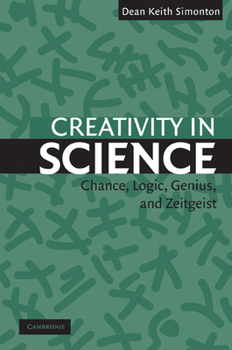Creativity in Science: Chance, Logic, Genius, and Zeitgeist
Select Format
Select Condition 
Book Overview
Psychologists, sociologists, philosophers, historians - and even scientists themselves - have often tried to decipher the basis for creativity in science. Some have attributed creativity to a special logic, the so-called scientific method, whereas others have pointed to the inspirations of genius or to the inevitable workings of the zeitgeist. Finally, some have viewed scientific breakthroughs as the product of chance, as witnessed in the numerous episodes of serendipity. Too often these four alternative interpretations are seen as mutually exclusive. Yet the central thesis of this book is that the chance, logic, genius, and zeitgeist perspectives can be integrated into a single coherent theory of creativity in science. But for this integration to succeed, change must be elevated to the status of primary cause. Logic, genius and the zeitgeist still have significant roles to play but mainly operate insofar as they enhance, or constrain the operation of a chance combinatorial process.
Format:Paperback
Language:English
ISBN:052154369X
ISBN13:9780521543699
Release Date:May 2004
Publisher:Cambridge University Press
Length:216 Pages
Weight:0.90 lbs.
Dimensions:0.7" x 6.0" x 8.9"
Customer Reviews
2 ratings
Excellent
Published by Thriftbooks.com User , 17 years ago
Simonton is a lucid thinker and lucid writer, so I found this book a delight to read, though it's a challenging delight because it reads much like a PhD thesis, with careful reasoning, abundant use of empirical data, and more quantitative analysis than one might have expected. But that rigor is worth dealing with because many of Simonton's conclusions turn out to be counterintuitive. What is his central conclusion? In a sophisticated way, Simonton makes a strong case that chance (luck) is the dominant factor in scientific creativity and success, while also recognizing the supporting roles of genius (inborn ability), zeitgeist (culture), and logic (basic knowledge of one's scientific domain and its rules of inference). Yet Simonton also notes that "chance" isn't strictly random and out of our control, since the odds of coming up with important results can be increased by factors such as hard work (eg, increasing number of papers published), exposure to diverse and numerous influences, and fostering an iconoclastic attitude (willingness to think "outside the box," in opposition to prevailing paradigms). To place this book in a more "popular" context, please see my December 30, 2008 review of Outliers: The Story of Success by Malcom Gladwell. The bottom line is that I highly recommend this book to anyone interested in creativity and success in science, both at individual and group levels. The book requires sustained concentration, but the effort is well worth it. This book itself exemplifies creative and successful scientific work!
book review
Published by Thriftbooks.com User , 20 years ago
Simonton, Dean Keith. "Creativity in Science: Chance, Logic, Genius, and Zeitgeist." Cambridge University Press. Cambridge, UK: 2004. This book is essentially an extended academic paper supporting this professor's argument for the causes of and correlations with creativity in science. The main idea of the book is that creativity in science is a function of chance, logic, genius, and zeitgeist. Simonton argues that the other 3 are included under the heading of chance. This is a very interesting idea because the conventional wisdom is that genius is the principal player in scientific creativity, and many would not be happy with suggestions otherwise. The main theory proposed by Simonton is that creative genius is simply a product of random and possibly unrelated ideas being combined in an interesting way through the combinatorial process. Simonton then makes a series of assumptions. From his theory and the assumptions, he concludes the existence of the equal-odds rule, which has been supported by empirical data. The equal-odds rule says that the average publication of any particular scientist does not have any statistically different chance of having more of an impact than any other scientist's average publication. In other words, those scientists who create publications with the most impact, also create publications with the least impact, and when great publications that make a huge impact are created, it is just a result of "trying" enough times. This is an indication that chance plays a larger role in scientific creativity than previously theorized. This book is filled with interesting quotes. One of my favorites is from a famous physicist named Bohr speaking about another theory. He says, "we are all agreed that your theory is crazy. The question which divides us is whether it is crazy enough to have a chance of being correct. My own feeling is that it is not crazy enough." This is an example of the kind of traits present in creative scientific people. The chart on the next page summarizes Simonton's findings in relation to the development, birth order, and disposition of creative minds in a concise way. As you may notice from the figure, Simonton also makes distinctions between artistic and scientific creativity. He argues that since logic is a requirement for all scientific creativity, and a detriment to most artistic creativity, these two types of creativity are very different. In addition, it is interesting to note that if a certain scientist never existed, their work would be replaced eventually be something similar, while this is not true for artists. He also argues that there is a stronger correlation in artistic creativity, with psychopathology, unconventional development, and other aspects on the figure below that lead to more random inputs in the combinatorial process.






